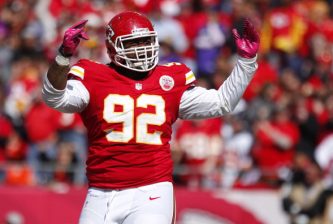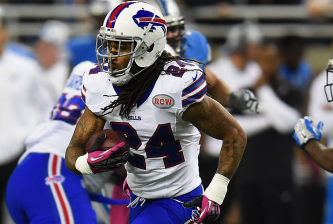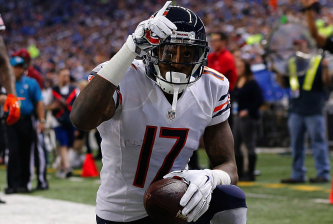When the St. Louis Rams drafted Sam Bradford in 2010 with the first overall pick, the front office thought they had rostered a franchise quarterback. That’s the belief of every general manager who uses the top pick on the most important offensive position.
No, it’s an assumption. On draft day there’s a sense of relief in knowing that for at minimum the next decade, quarterback security has arrived, and the GM in question doesn’t have to crank the quarterback draft slot machine again.
But it’s never quite that peachy and perfect. There’s regression, expectations that aren’t met, and general failure. Worse, muscles are torn and careers are derailed. Bradford’s fate has now fallen into the latter category. Twice.
Bradford tore his left ACL when he fell awkwardly during Saturday’s preseason win over the Browns. He’s now torn the same ligament twice in less than a year after going down in Week 7 last fall with the identical injury.
At best he’s an average quarterback, though there’s value in average, and having familiarity and continuity under center. That’s especially true for the Rams, a team which has invested highly in Bradford’s receiving options in recent years, spending a first-round pick on Tavon Austin and signing Jared Cook.
Long-term this will lead to a difficult decision. After missing the upcoming season Bradford will be set to enter the final year of his contract in 2015 having then sat out 31 of a possible 80 career games. He’s fragile, and he’s also unreliable, often showing an inability to push the ball downfield aggressively. Over 49 career starts he has a per attempt rate of only 6.3 yards, and a career per game pace of 225.8 yards.
Those aren’t the numbers of long-term stability, but the other option is taking another spin on the quarterback draft carousel. The choice next spring is between fragile and familiar. Good luck with that.
The immediate concern right now, though, is a short-term solution. The next man up is Shaun Hill, who’s earned the reputation of being one of the league’s better backup quarterbacks, mostly by not screwing up often. Over 34 career game appearances he’s thrown 41 touchdown passes and 23 interceptions, clipping along at a per attempt rate of 6.7 yards.
That’s pretty OK, and pretty average, meaning at worst the step down from Bradford to Hill won’t be overly significant. Right now that says far more about Bradford than Hill. While he is indeed a fine backup, the reality is that the with rare exceptions (hi there, Josh McCown) a team is screwed if it has to trot out a backup quarterback for any more than a handful of spot starts.
The Shaun Hills of the NFL are little more than gap fillers, and temporary solutions. That’s especially true with Hill, a 34-year-old journeyman who hasn’t started a game since 2010, and has attempted only 12 regular-season passes over the past three years. That will lead to a steady lean on the run, just as we saw last year when Zac Stacy averaged 22.2 carries per game over the final nine weeks.
What other options are out there right now for a team that had plenty of uncertainty at quarterback this offseason and passed on Michael Vick, Matt Cassel, and Josh McCown, among others? Well, not a whole lot, with the trade market pretty bare and uninspiring.
Mark Sanchez? Sure, a Sanchez career resurrection is still quite possible. He’s young at only 27, and he’s played well this preseason, immediately clicking with Chip Kelly in Philadelphia. But Brian Schottenheimer is still calling the plays in St. Louis, and the last Sanchez-Schottenheimer marriage in New York ended horribly for everyone involved when the quarterback regressed in 2011, and the coordinator couldn’t right his wayward course. Neither party is interested in trying again because nothing would change this time.
Matt Barkley? The early returns on Sanchez in Kelly’s offense have been promising, so much that the Eagles plan to sit him in their fourth preseason game, not wanting to risk an injury to a player they value highly. If a quarterback on their roster gets traded, Matt Barkley is the more likely candidate.
Go ahead and laugh, because so far Barkley has deserved nothing more than your laughter. When both Vick and Nick Foles went down last year, a raw Barkley was pushed into action, which resulted in jittery feet and four interceptions on only 49 pass attempts.
But despite his fumbling (literal and otherwise), Barkley’s shine that would have made him a top 10 overall pick in 2012 had he declared may not be entirely gone. His NFL exposure has been exceedingly limited, and as Jimmy Kempski notes, multiple teams had interest in Barkley around the same draft territory where the Eagles grabbed him in 2013 (fourth round, 98th overall).
That shows there could still be optimism surrounding his development potential, and the trade price required to roll that dice would be a minimal risk (likely a fifth-round pick at best).
Kirk Cousins? A few punches were delivered to Cousins’ trade value last season. Of his three late-season stats, two were filled with woe, and he ended the year with a completion rate of only 52.3 while averaging 5.5 yards per attempt. Not good.
But Cousins’ name will always surface after a quarterback injury because, like Barkley, he has that magic combination of youth and promise. With Cousins there’s also still an element of mystery, as with only four career starts we haven’t seen him in extended action yet.
Maybe the Rams are willing to overlook his stumble last year on a Redskins team that was in complete disarray? Maybe, but with Robert Griffin III doing his face planting this preseason, the appetite for a Cousins trade in Washington is pretty low.
Ryan Mallett? This guy is Cousins long before Cousins, with his name forever tied to all quarterback trade hot stoving. But we may have finally (mercifully) reached critical mass for actual Mallett interest. The Patriots tried to showcase him this preseason, and Mallett responded by completing only five of his 12 pass attempts.
Tim Tebow? No. No no no no no. NO.
The problem then is one of cost, and return. The possibly available options who can be sort of trusted (Sanchez, maybe Cousins) will cost too much. And although the investment would be much lower, the uncertainty and praying required to embrace the likes of Barkley or Mallett as a starting quarterback would make front office hind regions sore from too much clenching.
So doing nothing is the likely ending. We live in a world where Shaun Hill could be a starting quarterback for a whole season.




